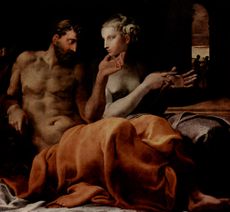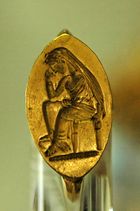Penelope
In Homer's Odyssey, Penelope (Greek: Πηνελόπεια, Pēnelopeia, or Πηνελόπη, Pēnelopē) is the faithful wife of Odysseus, who keeps her suitors at bay in his long absence and is eventually rejoined with him.
Her name has traditionally been associated with faithfulness,[1] and so it was with the Greeks and Romans, but some recent feminist readings offer a more ambiguous interpretation.[2]
Contents |
Etymology
The origin of her name is believed by some like Robert S. P. Beekes to be Pre-Greek and related to pēnelops (πηνέλοψ) or *pēnelōps (*πηνέλωψ), glossed by Hesychius as "some kind of bird"[3] (today arbitrarily identified with the Eurasian Wigeon, to which Linnaeus gave the binomial Anas penelope), where -elōps (-έλωψ) is a common pre-Greek suffix for predatory animals;[4] however, the semantic relation between the proper name and the gloss is not clear. Pēnelopē (Πηνελόπη) is usually understood to combine the Greek word pēnē (πήνη), "weft", and the ōps (ὤψ), "face", which is considered the most appropriate for a weaver of cunning whose motivation is hard to decipher.[5] Alternatively, the derivation pēnē and lepō (λέπω), "peel", due to the shroud-unweaving mytheme, has been suggested.
Role in the Odyssey
Penelope is the wife of the main character, the king of Ithaca, Odysseus (Ulysses in Roman mythology), and daughter of Icarius and his wife Periboea. She only has one son by Odysseus, Telemachus, who was born just before Odysseus was called to fight in the Trojan War. She waits twenty years for the final return of her husband,[6] during which she has a hard time snubbing marriage proposals from 108[7] odious suitors (led by Antinous and including Agelaus, Amphinomus, Ctessippus, Demoptolemus, Elatus, Euryades, Eurymachus and Peisandros).
On Odysseus's return, disguised as an old beggar, he finds that Penelope has remained faithful. She has devised tricks to delay her suitors, one of which is to pretend to be weaving a burial shroud for Odysseus's elderly father Laertes and claiming that she will choose a suitor when she has finished. Every night for three years, she undoes part of the shroud, until some unfaithful maidens discover her chicanery and reveal it to the suitors.

Because of her efforts to put off remarriage, Penelope is often seen as a symbol of connubial fidelity. Although we are reminded several times of her fidelity, Penelope does begin to become restless (due in part to Athena's meddling), and longs to "display herself to her suitors, fan their hearts, inflame them more" (xviii.183-84).[8] As Irene de Jong comments:
As so often, it is Athena who takes the initiative in giving the story a new direction . . . Usually the motives of mortal and god coincide, here they do not: Athena wants Penelope to fan the Suitor's desire for her and (thereby) make her more esteemed by her husband and son; Penelope has no real motive . . . she simply feels an unprecedented impulse to meet the men she so loathes . . . adding that she might take this opportunity to talk to Telemachus (which she will indeed do).[9]
She is ambivalent, variously asking Artemis to kill her and, apparently, considering marrying one of the suitors. When the disguised Odysseus returns, she announces in her long interview with the disguised hero that whoever can string Odysseus's rigid bow and shoot an arrow through twelve axe shafts may have her hand. "For the plot of the Odyssey, of course, her decision is the turning point, the move that makes possible the long-predicted triumph of the returning hero".[10]
There is debate as to whether she is aware that Odysseus is behind the disguise. Penelope and the suitors know that Odysseus (were he in fact present) would easily surpass all in any test of masculine skill. Since Odysseus seems to be the only person (perhaps excepting Telemachus) who can actually use the bow, it could merely have been another delaying tactic of Penelope's.
When the contest of the bow begins, none of the suitors is able to string the bow, but Odysseus does, and wins the contest. Having done so, he proceeds to slaughter the suitors – beginning with Antinous whom he finds drinking from Odysseus' cup – with help from Telemachus, Athena and two servants, Eumaeus the swineherd and Philoetius the cowherd. Odysseus has now revealed himself in all his glory (with a little makeover by Athena); yet Penelope cannot believe that her husband has really returned—she fears that it is perhaps some god in disguise, as in the story of Alcmene—and tests him by ordering her servant Euryclea to move the bed in their wedding-chamber. Odysseus protests that this cannot be done since he made the bed himself and knows that one of its legs is a living olive tree. Penelope finally accepts that he truly is her husband, a moment that highlights their homophrosyne (like-mindedness).
In one story of the Epic Cycle, subsequent to Odysseus' death, Penelope marries his son by Circe, Telegonus, with whom she becomes the mother of Italus. Telemachus also marries Circe when Penelope and Telemachus bring Odysseus's body to Aeaea.
In conclusion, Penelope is one of the few strong women characters seen in Odyssey. Though she has not seen Odysseus in twenty years, and despite the pressure from the suitors trying to make her remarry, she never loses loyalty towards her husband. She does have help from Athena, who often visits her in dreams to reassure her. Though she does prove that she loves Odysseus, she still responds to the suitors with some uncertainty. She does not refuse to marry the suitors but she does put off her decision to remarry, leading them on with promises that she will choose a new husband as soon as certain things happen. Her shrewd delaying tactics expose her sly and artful side. Her plan of not remarrying until she completes a burial shroud that she knows she will never complete buys her time.

Iconography
Penelope is immediately recognizable in Greek and Roman works, from Attic vase-paintings — the Penelope Painter is recognized by his representations of her — to Roman sculpture copying or improvising upon classical Greek models, by her seated pose, by her reflective gesture of leaning her cheek on her hand, and by her protectively crossed knees, reflecting her long chastity in Odysseus' absence, an unusual pose in any other figure.[11]
Notes
- ↑ J.W. Mackail, with Penelope in the Odyssey (Cambridge University Press, 1916), epitomizes the traditional view of the dutiful Penelope.
- ↑ Marylin A. Katz, Meaning and Indeterminacy in the Odyssey (Princeton University Press, 1991)
- ↑ Γλῶσσαι.
- ↑ Zeno.org lemma relating πηνέλωψ (gen. πηνέλοπος) and <χην(ά)λοπες>· ὄρνεα (predators) ποιά. ὅπερ ἔνιοι <χηναλώπεκες.
- ↑ For the mythology of weaving, see Weaving (mythology).
- ↑ Odysseus spends ten years in the Trojan War and ten years travelling home.
- ↑ Homer. The Odyssey, Book XVI, in The Iliad & The Odyssey. Trans. Samuel Butler. p. 628. ISBN 9781435110434
- ↑ Many modern readers have commented that this is not an action entertained by an ordinary Hellenic wife, but the contemplated act of a goddess: an epiphany.
- ↑ A Narratological commentary on the Odyssey,p. 445, Irene de Jong, Cambridge University Press, 2001 ISBN 0 521 46844 2'
- ↑ Bernard Knox, introduction to Robert Fagles's translation of The Odyssey (1996:55).
- ↑ But compare, for an unusual exception, the seated aulos player on the "Ludovisi Throne.
Primary sources
- Ovid, Heroides I
- Homer, Odyssey
- Lactantius Placidus, Commentarii in Statii Thebaida
Secondary sources
- Finley, M.I. The World of Odysseus, London. Pelican Books (1962)
- The Penelopiad by Margaret Atwood retells the story of Odysseus from the point of view of Penelope.
- Seth L. Schein, ed. (1996). Reading the Odyssey: Selected Interpretive Essays. Princeton University Press. ISBN 0-691-04440-6.
- del Giorgio, J.F. The Oldest Europeans A.J.Place (2006). It underlines Penelope's power and her role in a cataclysmic time.
- Richard Heitman (2005). Taking Her Seriously: Penelope and the Plot of Homer's Odyssey. Michigan University Press, Ann Arbor. ISBN 0-472-11489-1.
External links
- Odyssey in English on the Perseus Project
- Penelope Unravelling Her Web - a painting of Penelope by Joseph Wright of Derby (from the Getty Museum)
|
|||||